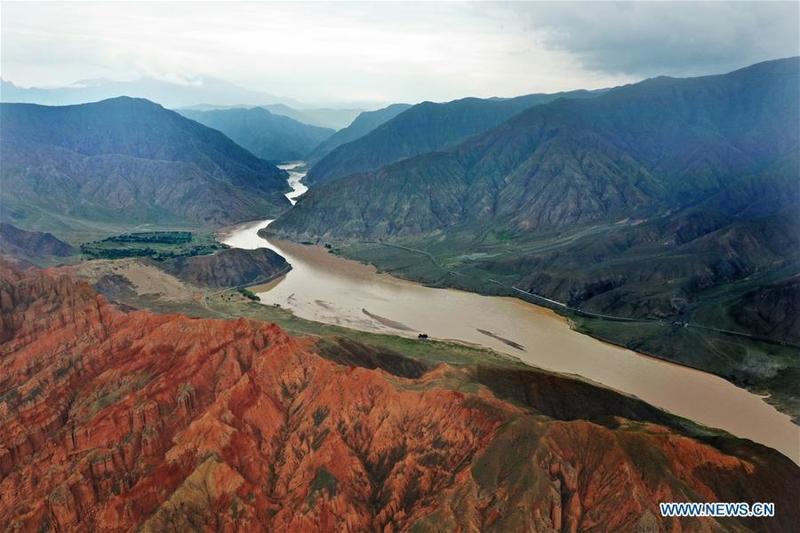 This aerial photo taken on Aug 7, 2020 shows a view of the upper stream of the Yellow River in northwest China's Qinghai province. (XING GUANGLI / XINHUA)
This aerial photo taken on Aug 7, 2020 shows a view of the upper stream of the Yellow River in northwest China's Qinghai province. (XING GUANGLI / XINHUA)
The Yellow River has seen continued improvements in its water quality, with the degradation of its ecosystem "preliminarily curbed", as the country's central leadership attaches increasing importance to the conservation of China's second-longest watercourse.
In its efforts to promote environmental protection and high-quality development in the basin of China's "mother river", the Ministry of Ecology and Environment has been researching the introduction of green-development-based taxation and government assessment mechanisms, Lian Yu, acting head of the ministry's bureau that oversees the river, said in an exclusive interview with China Daily.
Overall, water quality in the main stream of the river has reached Grade III or better. The degradation of the ecosystem in the basin has also been preliminarily curbed.
Lian Yu, Acting head of the bureau that oversees the Yellow River, Ministry of Ecology and Environment, China
President Xi Jinping has attached great importance to the Yellow River and has visited it several times during inspection tours to various provinces and regions. Exactly a year ago, on Sept 18, 2019, while chairing a symposium during an inspection tour of Henan province, Xi called for concerted efforts to promote the protection and high-quality development of the river.
"The protection of the Yellow River is critical to the great rejuvenation and sustainable development of the Chinese nation," Xi said, adding that it is a major national strategy.
ALSO READ: Yellow River plays role in 'rejuvenation'
Calling for strengthened protection of the Yellow River basin's ecosystem, Xi said that differences between the upper, middle and lower reaches of the river should be fully considered, given that its ecosystem is an organic whole.
Lian said the water quality in the Yellow River Basin has been improving. Last year, 73 percent of water in the monitored sections was classified at Grade III or above in the country's five-tier water quality system, compared with 61.2 percent in 2015. Meanwhile, 8.8 percent of the water was below Grade V, the poorest quality, compared with 12.9 percent in 2015.
"Overall, water quality in the main stream of the river has reached Grade III or better," he said.
"The degradation of the ecosystem in the basin has also been preliminarily curbed," Lian said, attributing this to the relatively strong flow in the river in recent years, which has aided remediation, and the government's efforts to promote the coordinated management of the environment.
Lian's bureau has established a comprehensive law enforcement team to ramp up coordinated and unified management of water resources in the basin that gives full consideration to environmental protection.
The bureau, which is headquartered in Zhengzhou, capital of Henan province, was set up in 2019 following the establishment of the Ministry of Ecology and Environment in 2018.
With its source in Qinghai province, the Yellow River is known as the cradle of Chinese civilization. It runs through nine provinces and autonomous regions including Shaanxi and Henan before emptying into the Bohai Sea in Shandong province. The 5,464-kilometer waterway feeds about 12 percent of China's population, irrigates about 15 percent of arable land, supports 14 percent of national GDP and supplies water to more than 60 cities.
Lian said red lines for protection of the Yellow River have been drawn in all nine provincial-level regions it flows through and work on establishing various kinds of protected land has forged ahead.
READ MORE: Yellow River can lead way to greener recovery
Water and soil conservation measures in the basin have helped reduce the amount of sediment entering the Yellow River by an average of 435 million metric tons a year, he added.
The river got its name because of its yellow, muddy water, which appears as it runs through the Loess Plateau in northwestern China.
Lian said there are still great challenges in promoting the river's protection. For example, three-quarters of the grassland in its source region is degraded.
A series of measures are in the pipeline to ramp up environmental protection in the river basin. While promoting compensation for those who forgo economic activity to protect its environment, Lian's bureau has also been researching the introduction of a green index-based taxation system for the entire river basin and a government appraisal system that takes account of green, low-carbon and circular development.
"The bureau will establish a resources and environment assessment system and make it part of the government's performance evaluation," he said.


